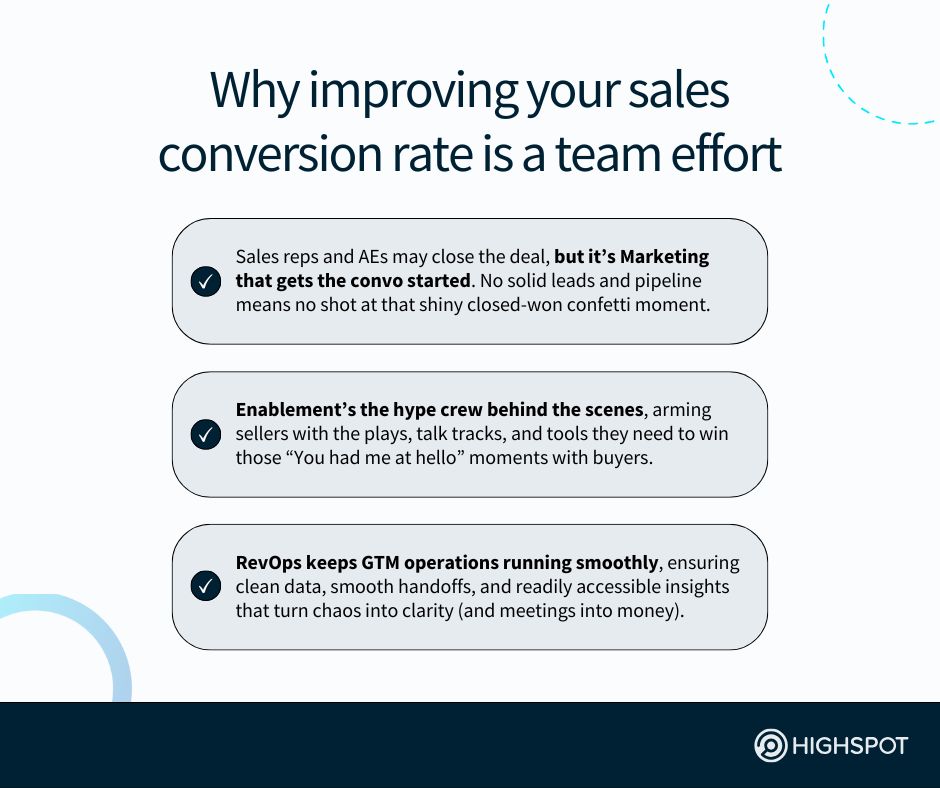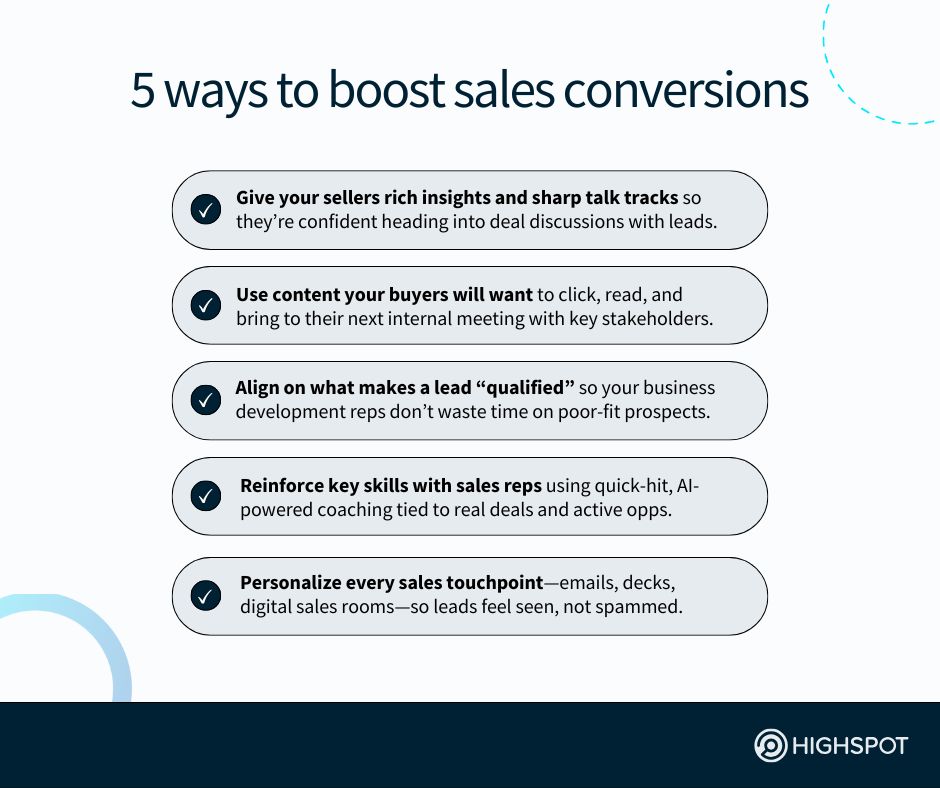Key Takeaways
- To increase your sales conversion rate, focus on what today’s B2B buyers care about, tighten talk tracks, and use pipeline insights to drive smarter plays that get reps closer to yes, faster, and with less friction.
- Boosting your lead conversion rate means turning engaged prospects into paying customers with less lift. You can do so by optimizing your handoffs, personalizing outreach, and using social proof that speaks to what each lead needs to hear regarding their distinct business needs and challenges.
- It’s a true team effort by everyone in go-to-market (GTM) to consistently elevate your sales conversion rate. When sales, marketing, enablement, and RevOps align, growing conversions is a standard you can scale.
While marketing is laser-focused on lead generation, sales teams are just as zeroed in on getting those potential customers to the proverbial finish line.
Put another way:
- For marketers, it’s about getting more qualified leads in the digital door via digital marketing campaigns, paid ads, and other tried-and-true demand generation activities that get more website visitors and lead-capture form fills.
- For sellers, it’s about ensuring they work in harmony with enablement personnel to deliver messaging and content that has a significant impact, in terms of targeted, personalized buyer engagement and advancement in the sales cycle.
If you’re not already treating improving your conversion rate like one of the most important revenue operations KPIs that it is, just remember your competition certainly is—and likely leveraging their sales analytics software to make continual, data-backed changes to continually increase closed-won numbers.

What is sales conversion rate?
Sales conversion rate measures how effectively your go-to-market teams collectively turn potential buyers into new customers. It’s a sharp-edged performance lens that helps objectively measure the actions and behaviors that move deals forward.
The metric helps you see what’s working with your GTM teams’ collaborative efforts to turn quality leads into paying customers at scale and make data-driven adjustments to your enablement approach, marketing efforts, and sales process as needed.
Converting leads into clients might sound simple in theory, but executing it in practice is a complex process full of friction, nuance, and shifting buyer expectations.
That’s why high-performing enterprises set conversion rate goals based on goals tied to revenue targets, the product roadmap, rep readiness, and deal velocity.
What’s the standard sales conversion rate formula?
The most commonly used conversion rate formula calculation is: (Total Number of Sales / Total Qualified Leads) x 100. This formula provides a baseline percentage that teams can use to benchmark effectiveness across the funnel.
It can help you identify whether your efforts converting contacts created via lead-generation activities and others who sales reps reach out to proactively are consistently moving the needle. Keep in mind how you define ‘qualified’ and when you measure ‘closed’ in your pipeline can change this calculation’s usefulness.
Which sales conversion metrics should leaders track?
Go-to-market and revenue operations leaders should focus on a mix of top-of-funnel, mid-funnel, and close-stage KPIs to understand what drives results. These include key metrics such as conversion by lead source, SQL conversion rate, prospect qualification rate, demo-to-close rate, and average deal size.
To boost conversion performance, correlate these metrics with sales data like rep activity, enablement content usage, and customer engagement signals.
What’s the average conversion rate for sales teams?
The average conversion rate for sales teams depends on industry benchmarks, deal complexity, sales motion, and GTM maturity. Many B2B teams tend to see lower averages than B2C, and even then, the gap across verticals can be wide.
More important than chasing a general average is knowing the multiple factors that influence your team’s rate and how it maps to pipeline coverage.
What’s considered a ‘good’ conversion rate for sales?
What defines a good conversion rate varies, based on product type, sales motion, deal value, and customer journey stage. Your organization’s leaders should set goals that reflect growth targets, buyer dynamics, and team readiness.
A strong rate signals you’re converting at a pace and volume that sustains forecast and supports efficient scaling. It should also be high enough to ID repeatable, coachable behaviors that create a sales performance ceiling worth breaking.
Which tools can help improve sales conversion rates?
The most effective tools for improving conversion rates are purpose-built to align your people, content, data, and workflows. That includes a CRM system, sales enablement platform, and other data-driven GTM solutions, especially ones that offer actionable, AI-powered insights to inform your sales and marketing efforts.
Sales analytics software, in particular, plays a pivotal role in surfacing patterns, blocking issues, and forecasting sales more accurately. When connected, these systems can help you make smarter decisions at every stage of the buyer journey and more effectively progress prospects through the sales funnel.
How the most successful GTM teams boost their sales conversion ROI
Your conversion rate isn’t a ‘soft’ sales metric. It’s a hard truth. The kind that shows up in board slides, sales dashboards, and late-night rep Slack messages.
High-performing sales team members know the key performance indicator is their North Star, must-improve metric. And yet, for too many B2B sales managers today, getting their reps to seal the deal with qualified leads in their pipeline.
These GTM leaders—perhaps even you—are asking the right questions:
- Which specific sales rep behavior do we need other sellers to replicate?
- Which particular stages in the deal cycle tend to ‘break’ our process?
- Which exact sales plays are working this week, month, and quarter?
But too many of these go-to-market leaders aren’t taking the right action—or, in some cases, using the right sales tools—to capably and quickly track lead conversion rates by business size, industry, territory, and other firmographic data.
It’s clear: Your sales reps want repeatability. You and other sales leaders want data-backed direction. And RevOps? They want all sales efforts to impact revenue.
That’s why improving conversion isn’t just about working harder. It’s about working smarter. It means knowing which distinct selling activities and behaviors accelerate deals, which ones tank them, and how to take the appropriate action.

The most successful GTM leaders today understand that improving their lead conversion metrics and realizing increasingly stronger sales performance means:
Sales reps tighten deal execution by leading every call with buyer-aligned outcomes
Top-performing reps anchor every conversation in the buyer’s goals, not just their product. Notably, they use deal-specific insights to tailor talk tracks, surface relevant proof points, and ask smarter discovery questions.
When the message sticks and next steps are clear, BDRs accelerate decision-making and improve close rates across similar personas and use cases.
Sales managers drive higher conversion by coaching reps on real deal performance gaps
Top sales managers don’t wait for QBRs to give feedback. Instead, they coach in the moment, based on real pipeline activity. Rep scorecards, meeting insights, and performance benchmarks pinpoint where deals go sideways and managers the chance to intervene before discussions with buyers go off the rails.
Instead of offering sales reps generic advice, managers focus on specific winning behaviors that help sellers close faster and more consistently. That targeted instruction creates a multiplier effect across the team and inspires confidence.
Marketing fuels conversion results by prioritizing content tied to revenue outcomes
High-impact marketing teams obsess over what collateral, messaging, and plays actually helps reps win, not just what targeted advertising gets clicks.
Consider marketers who use Highspot. They use data tied to sales enablement metrics to analyze which assets resonate with potential customers and help close deals faster, then double down on what works to empower their entire sales team.
This shift from content creation and curation to constant iteration and optimization ensures marketing helps sellers have high-converting resources to share with prospects at every stage of the B2B buying journey. This, in turn, allows marketers to connect campaign performance directly to pipeline lift.
Enablement raises conversion performance by reinforcing buyer-facing behaviors
Leading enablement teams don’t just roll out sales training programs. They embed behavior change into reps’ flow of work and use AI-assisted practice, coaching feedback, and call analysis to reinforce messaging and skill mastery over time.
They also work with marketing to ensure only relevant content and related usage guidance is given to BDRs so they can properly leads’ pain points on calls.
The data backs it up: Reps who practice the right things (and even make mistakes) in sales role play exercises and get timely feedback show up sharper when it counts and have more impactful conversations with quality leads.
This equates to more consistent execution and a faster path from pitch to purchase.
RevOps boosts conversion rates by linking activities to outcomes in real time
The best revenue operations orgs don’t just report. They also diagnose and guide.
RevOps tracks rep behaviors, content usage, and meeting insights across systems, then identifies where deals stall or accelerate. This lets them quickly adjust GTM motions, spotlight what’s working (and what isn’t), and scale best practices.
When all go-to-market and revenue teams operate on the same signals (read: the same, unified GTM data set), conversion invariably improves like clockwork.
“Shared insights are more robust, fueling strong demand generation messaging and more compelling interactions,” Gartner VP, Advisory, KI Leader Kristina LaRocca-Cerrone shared during a recent Gartner Marketing Symposium/Xpo. “For example, where marketing captures the full customer journey across channels, sales has access to common customer pain points and journey triggers.”
Discover how Highspot customer SkinCeuticals elevated its sales conversion rate with help from our agentic platform for go-to-market teams.
7 sales conversion rate optimization best practices for your GTM teams
Ongoing education of your sales force is the cornerstone of any strong go-to-market strategy. But your training efforts must be coordinated and purposeful.
“Sales training programs need to have clearly articulated goals to inform the direction of the program and to help understand whether it works or doesn’t,” Highspot’s Sales Training Guide to Boost Rep Effectiveness explains. “When setting training objectives, think about the specific behaviors you want to improve, like reducing ramp time or increasing conversion rates.”
Of course, training alone won’t be enough to take your sales conversion rate to new heights. To accomplish that, you and other GTM teams must:
1. Track stage-specific lead conversion metrics across the entire sales funnel
You can’t improve what you don’t measure. That includes how buyers move from the beginning of the B2B buying journey all the way to close, lost, or no-decision. Stage-specific metrics give you clarity on where qualified leads slow down or drop off and why so your managers and reps can rectify any funnel issues.
Notably, you can identify areas where reps need coaching, enablement, or content support. These insights let your RevOps and sales leaders fine-tune their pipeline generation strategy with a direct impact on your sales conversion rate.
The key is looking beyond a single metric and focusing on where conversion gaps widen across buyer stages, personas, or regions—and acting accordingly.
2 Map sales plays and content to buyer signals, not internal sales process steps
The strongest B2B sales teams today align their segment- and product-specific plays and messaging to what buyers care about at that moment. Effective sales plays connect content directly to prospect priorities, pain points, and buying triggers.
Instead of sticking to rigid process stages, equip your selling teams with modular messaging and content that flex with the conversation, as new pain points and pushback arise. This approach ensures every sales pitch feels relevant to leads’ needs and enhances your lead conversion rate across varied deal types.
By shifting your play design to start with buyer signals and work backward, GTM teams can drive more meaningful engagement and higher sales conversions.
3. Equip reps with enablement that drives repeatable, high-impact selling behaviors
Equipping your reps doesn’t mean flooding them with generic decks or lengthy training modules that sit unused. High-performing sales enablement teams deliver reps just-in-time guidance tied to their pipeline and performance.
With Nexus™, Highspot’s unified AI and analytics engine, you can connect what’s spoken, shared, and shown across the funnel to deliver signals that matter. This means every learning path, asset, and skill focus is based on actual engagement behavior data, not assumptions or outdated templates.
Over time, this insights-driven approach creates a feedback-rich system of enablement that continuously lifts rep confidence and closes pressing go-to-market performance gaps that prevent you from realizing stronger revenue growth.
4. Create AI-assisted feedback loops between live calls, coaching, and rep training
Sales managers can accelerate rep improvement by linking training with how reps actually show up in live selling scenarios. One of the best ways to do this is to analyze deal performance using conversation insights, then tailor training content and manager coaching accordingly.
In Highspot, managers, reps, and enablement leaders alike can create a custom-tailored digital sales room built purposely and solely for specific leads to reinforce skill-building with curated plays, training assets, and real-time buyer engagement.
Digital sales rooms are essentially bespoke, interactive landing pages featuring content, messaging, and proof points that map to the rep’s specific sales stage and buyer profile. By using tools that mirror how reps sell and learn, paired with AI-powered feedback, you create reinforcement that sticks.
That said, as Highspot’s Power of DSRs for Go-to-Market Strategies Guide noted, “Simply creating a digital sales room isn’t enough” to realize GTM success.
“Organizations have a great opportunity to get creative and strategic when designing and using DSRs,” per the guide. “Sales teams and leaders need to go beyond expected features and think about delivering an engaging and dynamic experience.”
5. Tailor buyer engagement using insights from CRM and past deal outcomes
Modern B2B buyers expect sellers to know their challenges, priorities, and what’s already been discussed—especially across long, multi-threaded cycles.
Pulling in CRM data, activity history, and closed-won trends gives reps the signals they need to tailor every sales pitch and follow-up. This helps reps speak directly to the buyer’s context and shortens the time it takes to move from interest to decision-making.
For instance, you can share social proof like case studies and testimonials from review sites tied to the buyer’s industry and persona to build trust quickly.
Personalization isn’t optional anymore. It’s table stakes, and the standard for converting high-quality leads requires reps to lead with insight, not intros.
6. Standardize sales qualification and handoff criteria across teams and tools
When sales, marketing, and RevOps use different criteria for qualification and lead handoff, conversion stalls before it even starts. Standardizing what makes a lead “qualified” ensures better alignment and more accurate forecasting across GTM teams.
It also reduces friction during handoffs between SDRs, AEs, and CS—accelerating velocity and improving your lead conversion rate. By using shared qualification fields in your CRM and syncing expectations across onboarding and coaching, you create consistency from first touch to closed-won.
More importantly, everyone in GTM understands what success looks like at every handoff moment—and fewer opportunities fall through the cracks.
7. Audit and optimize content, based on actual usage and revenue contribution
Sales teams need content that converts, not just content that looks good in a deck.
Use data to determine which assets are landing with buyers, influencing deals, and driving next steps in the pipeline. If a piece of content isn’t getting used or influencing close rates, rework it, replace it, or retire it.
Your go-to-market teams should regularly review usage by asset type, persona, and deal stage to guide both creation and content governance decisions.
Over time, this ensures your sales performance management efforts are focused on helping reps deliver materials that earn and maintain prospects’ attention and, at the end of the day, contribute to a higher sales conversion rate.
Why using agentic AI to realize higher sales conversion rate is a must today
Your people and processes matter a great deal in your collective efforts to augment your sales conversion rate. But don’t forget the role that cutting-edge AI sales tools play in your near- and long-term go-to-market performance.
With an agentic platform like Highspot—one that’s purpose-built for modern GTM teams—at the center of your sales tech stack and ‘speaking’ with other essential tools, including your CRM, you can get valuable insights when and where you need them so reps show up smarter and move faster in deal discussions.
More to the point, you can leverage AI sales agents, like our Deal Agent that offers real-time deal intelligence insights to provide recommended next-best actions to sellers and reveal what tactics can help move the needle with closing.
“Imagine creating a perfect replica of your top-performing sellers—but instead of someone whose capacity for work is limited by time and geography, this replica can work alongside human sales reps continuously,” McKinsey & Co. partners recently wrote for Harvard Business Review.
That’s what AI agents offer.
Bottom line: The use cases of AI for sales continue to grow—but the goal of using artificial intelligence, regardless of tool, is the same: Improve your lead conversion rate so you can drive predictable revenue growth and help reps meet quota.
When you have an agentic go-to-market platform synced with other essential sales solutions, you can create a highly effective revenue-acceleration engine.




